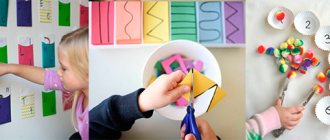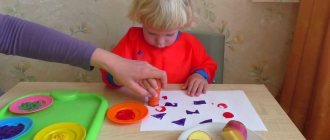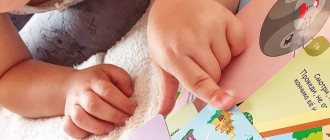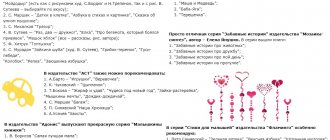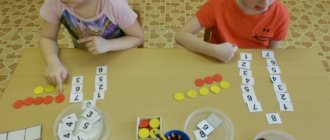A child aged 1 to 3 years belongs to the category of young children. During this period, the active formation of all organs and systems occurs. But along with the rapid pace of physical maturation, the psycho-emotional development of children is intensively improving. In order for a little person to successfully master speech, object and play activities, dexterity of movements, the basics of creativity and creative thinking, it is not enough to simply follow the correct daily routine and provide adequate nutrition. Additional developmental activities are necessary for children.
For 1-year-old children, the most important thing is play.
Of course, you can find the most suitable studio that provides specialized classes for young children. Or you can create a set of exercises yourself and conduct training at home.
Directions for the development of children from one to 3 years old
Basic types of exercises for conducting classes with a small child
Classes with a 1-year-old child are aimed at transmitting information in a playful way. It is very important to interest children in engaging in the process of cognitive activity. If the offered games do not seem interesting to the baby, then the mother will not receive any concentration. You can use any available materials as props: bright mittens, colored pictures, soft toys, plastic dishes.
Montessori educational toys
- “I call - and you look.” A child of the first year of life, although he can already pronounce individual words, does not yet have sufficient speech skills to conduct a full-fledged dialogue. Therefore, parents need to encourage children to actively pronounce sounds. The game when the baby has to show the object named by the mother helps not only to improve imaginative thinking, but also to develop the speech apparatus. Because the child will try not only to find the right thing, but also to repeat its name after the adult.
- Finger gymnastics. The better the fine motor skills of the hands are developed, the faster memory, speech and thinking improve. Hand massage, salt dough modeling, lacing games are perfect for small children. It makes more sense to find funny poems to practice with. This way the child will be more willing to get involved in the process. Together we will build a house (fold your hands into a “house” and raise them above your head). Let there be windows in it (to form circles of fingers). And also so that there is a door (the brushes form a rectangle). And let the pine tree grow (raise your hands up, spread your fingers). And there was a fence around (we move our palms along an imaginary wall). The dog guarded the gate (hands “locked”). And then let it rain (fingers “drum” on the body). And the flower in the garden bloomed (put your palms together and imitate the opening of a bud).
Finger games in drawings - Exercises for children to develop movements. Undoubtedly, sooner or later instincts will take over, and the baby will learn to crawl, walk, run and jump. But if mom provides help, then all processes will proceed much faster. We ask the child to squat, climb stairs, step over obstacles, and catch the ball.
- Dancing. For such activities with children, it is better to choose songs that sing about performing some action. For example, “put your right hand forward, and then back…” and so on. The mother makes the movement, the child repeats. This dance-game form of classes helps improve coordination of movements, form spatial perception of the surrounding world and make associations between actions and names.
Dancing for little ones develops coordination of movements - Role-playing games for children are indispensable helpers in improving their abilities. Play the role of a mother and put the toy to bed, imagine yourself as a driver and fix the car, treat a book, wash the dishes, wash clothes for the doll - everything that will give you a boundless flight of imagination. It is much simpler and easier for a child to learn about the world around him if there are caring and loving parents next to him, helping him and guiding him in the right direction.
- Games for the relationship between shapes, colors and sizes of objects . Children need to be taught not only to recognize the external characteristics of objects, but also to distribute them into groups in accordance with given parameters. Parents invite the child to put the largest objects into a box first, then very small ones, then hard - soft, then round - square - triangular, and finally the objects are sorted according to color parameter.
- Modeling lessons can be started from 1.5 years of age
- Educational activities with children on the street . Do not forget about the optimal combination of business and pleasure. While walking in the fresh air, you can do many exercises to improve various skills and abilities. On the street it is easy to find objects to observe, imitate and look at with children. And at the same time, teaching your child to respect nature is doubly useful.
Children play role-playing games from the age of 2.
Parents should know that all games are carried out with mandatory commentary on the process. The mother should tell the baby what is happening now and why this is being done.
It is important not only to provide sensory perception, but also to conduct speech association. For example, if a child is holding a soft object in his hands, then it is advisable to report this. Thus, developmental activities will be held with maximum benefit for children.
3. “Surpirziki” - developing fine motor skills.
Before the start of the lesson, you need to prepare a “surprise” for the child; wrap various objects in foil (or if there is none, just in paper).
Since the topic of the lesson is circles and balls, it would be great if we wrapped balls (different ones - hard, soft, smooth, etc.). But you can wrap other items too.
We put surprises in a bucket, basket or box and cover them with something (we create an element of surprise). It will be much more interesting for a child to unearth an unknown treasure than if he were simply asked to discover all the surprises.
- Oh, look at the box! The bunny probably left us a surprise! What did he put there??????????
Show how to open surprises, voice the object that was in the surprise (ball, soft, red, rough, etc.).
For some children, this task may seem quite difficult - it all depends on how developed the child’s fingers are (and, of course, on how much he likes the game itself). Before starting the game, evaluate the child’s developmental abilities; maybe you should put “surprises” on top that are not wrapped very tightly (they will be easier to unwrap).
Precautions for organizing gaming activities
We must not forget about safety rules. All items used for games should not have sharp corners, small parts, or toxic substances in their composition. It is better if these are specialized toys for children.
Drawing develops imagination and motor skills
Also, the place for games must meet the basic requirements:
- distance from wires and power supply;
- absence of glass doors, corner countertops, piercing and cutting objects;
- flat surface for movement.
If the mother can answer affirmatively to a number of questions, then the organization of play activities was as safe as possible. Does the item pose a threat to the child? Can I safely leave my baby alone with this item? Is it possible to leave the room for a short period of time without fear for the child’s health?
Tests for children 2-3 years old
What the future of children will be depends largely on their parents.
And you should start building a path to a bright life for your child here and now.
Being a mother is not just about finding a woman’s happiness, it is also about long and tedious work, a huge supply of patience and a sea of invested energy. But at the moment when the time comes to reap the fruits of their efforts, rejoicing in the significant successes of their child, not a single mother will remember the time spent and sleepless nights. leave a comment
First lessons
- We consolidate the concepts: big-small, many-little, identical;
- Learning colors;
- We study opposites on real objects (cold-hot, empty-full, heavy-light, soft-hard);
- We count everything around while communicating with the baby (steps, buttons, toys);
- We study geometric shapes;
- Viewing Doman cards or other educational material that expands your child’s horizons
Application - we develop our fingers, create, reinforce the concept of “circle”, “big-small”, learn colors.
From the age of one to two, the easiest way to teach a baby the names of colors and shapes is to say the name of the color and shape many times during the game (red circle, blue circle, etc.).
Cut out circles of different sizes and colors. We invite the child to stick them on paper in a random order. As we work, we comment on the color of each figure: “What a beautiful circle you took! It's red and big! And so on."
Or the application can be made with a plot:
- Look, what a baby elephant! He's bored! Let's stick some funny balls on him so he can play!
The file for printing the baby elephant (color and black and white) is here.
You can also draw a baby elephant, a kitten, or even just a little man yourself.
Attention training
The ability to notice little things and concentrate on a specific task are skills that develop children by leaps and bounds. Successful mastery of them will help children in further education.
Include the following activities in your daily activity:
- Search. This game does not need additional attributes, so it is interesting always and everywhere. It allows you to develop the attention of a child from 1 year. Ask your treasure to find a white toy in the basket, point out a squirrel in a picture, or hand him his favorite plastic cup.
- Selection of items. Place various objects on the table and ask your child to choose objects of a certain color or with the same pattern. For example, let your child give you yellow clothespins. If you constantly play with a child aged 1-3 years, the baby will complete the task faster each time.
- Construction of a tower or house. Help your child build a castle from a pile of large parts. Before purchasing “building materials,” be sure to look at the manufacturer’s recommendations. Not all games can be played with a child from 1 to 3 years old.
- Search for objects with the same characteristic. Ask your little one to show her white toys or choose round objects from those laid out on the table. In general, a wise parent can come up with 1000 and 1 variants of educational games related to the search for some objects. You can link two properties of an item into one chain. For example, soft and white.
